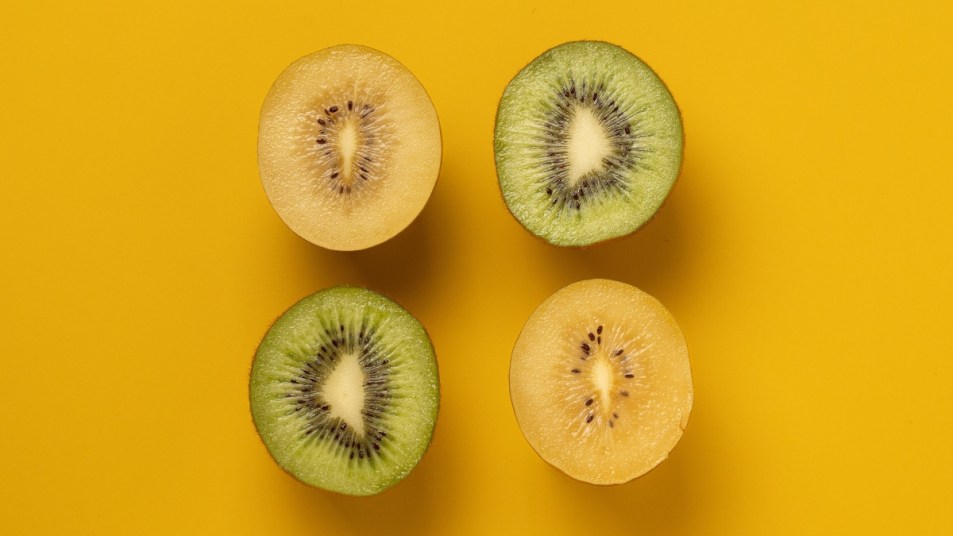Could Gold Kiwi Be Your New Favorite Fruit? Here’s the Scoop
A healthy treat that's less hairy than its green kiwi cousin.

At first blush, kiwis aren’t the most appealing fruit. They’re brown and hairy on the outside, and sour and seedy on the inside. Their bright green flesh is visually unique, but its sometimes-acidic flavor, as well as the hassle of removing the flesh from its hairy peel, are a turnoff to many. If you’re among the kiwi-averse, don’t swear them off just yet: Their cousins, gold kiwis, might become your new favorite fruit. Read on to learn more about gold kiwis and what makes them different from their green counterparts.
What is a gold kiwi?
Kiwis, which are botanically classified as berries, are said to have their native roots in China, where they were initially called Mihou Tao, or “sunny peach.” In the early twentieth century, a traveler from New Zealand brought seeds home, and the fruit became so popular there it started being grown all over the country. In 1958, it was renamed “kiwi” after New Zealand’s national bird.
After much natural cultivation and breeding, a less hairy, sweeter, golden-hued variety of the kiwi was born in New Zealand in the ’90s, says Zespri, the company responsible for its creation. The fruit became popular internationally, eventually surpassing New Zealand’s export volume of green kiwis in 2020, the gold kiwi experts at Livaux report.
What does a gold kiwi taste like?
If you don’t enjoy green kiwis, don’t assume you’ll dislike gold ones, too! Their exteriors are thin, light brown, and slightly fuzzy — not hairy, like a green kiwi. They’re so smooth and soft, in fact, that you could bite right into it like a peach, and the texture wouldn’t be unpleasant. On the inside, they’re bright yellow, and their flesh is soft, juicy, and sweet. They taste distinctly tropical, like a mixture of mango, banana, strawberry, and pineapple, with less acidity than their green counterparts. They also contain fewer seeds, so their texture is smooth. They’re sweet enough to go great with desserts (or even be a dessert on their own).
Gold Kiwi vs. Green Kiwi Health Benefits
You know gold and green kiwis look and taste different, but how do they compare nutritionally? They’re almost the same, with a few slight differences. Both fruits are an excellent source of Vitamin C — in fact, they’re higher in the nutrient than any other fruit by volume, says Livestrong, and gold kiwis have more Vitamin C than the green variety. Vitamin C is an antioxidant, and it promotes healthy bones, teeth, and skin.
Livestrong notes that gold kiwis also contain more folate, a B vitamin that promotes red blood cell production and nerve health, than their green counterparts. Both fruits contain equal amounts of potassium, which prevents high blood pressure, and antioxidant and immune-boosting vitamin E. They’re also both sources of lutein, a nutrient that supports eye health. Green kiwis contain more fiber and less sugar than gold, but both fruits are ultimately nutritional powerhouses.
Where can I buy gold kiwis?
The worst thing about gold kiwis is that they are generally less available than their green counterparts due to their more limited seasonality. While green kiwis are typically sold year-round, gold kiwis are mostly available from June to August. The good news is, many major grocery store chains carry them, including Costco and Walmart. Visit Zespri’s product locator to find the fruit near you.
Once you’ve struck gold (literally) and found this fruit in your store, use the following tips to make sure you’re getting the best quality kiwis:
- Do a visual check: Avoid signs of overripeness, like bruising, and choose fruit that looks slightly darker and hairier.
- Do a pressure check: If you’re not eating your gold kiwi immediately, buy harder fruit, since they have a short shelf life. There will be a slight give to the flesh when squeezed once it is ready to eat.
- Do a sniff check: Ideal, ready-to-eat gold kiwis have a citrus smell; if their scent is overly sweet, they may be overripe.
When it’s time to eat your gold kiwi, you can bite right into it, or cut it in half and use a spoon to scoop out the flesh. Alternatively, you can use a nifty part-spoon, part-knife kiwi-eating utensil (Buy from Amazon, $5.72). However you end up eating it, we hope you enjoy — it’s the closest possible thing to tasting sunshine.
















